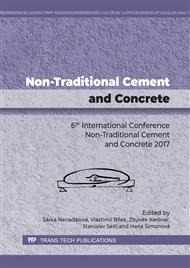p.127
p.131
p.135
p.144
p.148
p.152
p.159
p.163
p.169
New Test Method for Assessing the Carbonation Front in Alkali-Activated Fly Ash/Slag Pastes
Abstract:
Carbonation of the pore solution in alkali-activated materials (AAMs) produces alkali and/or alkali-earth carbonates. When the carbonate solubility in the water is very high (case of the most alkali carbonates), it is very hard to determine the carbonation depth in AAMs with the phenolphthalein indicator frequently used in Ordinary Portland Cement (OPC)-based materials. Carbonation gradually decreases the alkalinity of the pore solution, while the color after spraying phenolphthalein changes from colorless to pink when pH< 13 and changes back to colorless when pH< 8.2. The color change with phenolphthalein indicator may still exist in the less alkaline areas where carbonation may have already occurred. Therefore, using the indicator test is likely to underestimate the depth to which carbonation reaction has occurred in AAMs and more complete assessment is required. This study investigates the carbonation front in alkali-activated fly ash (FA) and blast furnace slag (BFS) pastes in natural laboratory conditions. Monitoring carbonation front in the samples after one year of exposure has been carried out under polarized light microscope (PLM), and environmental scanning electron microscope (ESEM). The carbonation products were sharply distinguished from the other constituents of the paste, by their crystallographic and optical characteristics under PLM, and characterized by X-Ray diffraction (XRD).
Info:
Periodical:
Pages:
148-151
Citation:
Online since:
January 2018
Authors:
Price:
Сopyright:
© 2018 Trans Tech Publications Ltd. All Rights Reserved
Share:
Citation:


